|
The predecessor of the council was the Local Board,
which originally held meetings in the upstairs room
at the disused malt house behind the White Lion public
house in King Street. By the 1870s this building was in
an advanced state of decay, the final decision to
abandon it being taken after someone threw a stone
through the window during a meeting. In November 1878
it was first proposed to build a new Town Hall with
public offices and a library, but it would be another
ten years before it came to fruition.
In July 1881 the Local Board borrowed £500 from the
government to purchase the land on which to build a Town
Hall. A piece of land was duly purchased in Pardoes Lane
where one of the town's two workhouses, now derelict, had been built.
It had ceased to be a workhouse in 1813. Plans were
submitted by Birmingham architect Jethro Cossins,
and were accepted on the condition that the project
would cost no more than £5,500 including £2,000 for the
library. Tenders were invited for the building work, and
the one submitted by Thomas Tildsley was accepted. Mr.
Tildsley undertook to erect the building at an estimated
cost of £3,500, which did not cover interior fixtures
and fittings. The foundation stone was laid on Tuesday
21st of June, 1887 by James Slater of Bescot Hall,
chairman of the Local Board, who had informed the Prince
of Wales that Queen Victoria's Golden Jubilee would be
commemorated in Darlaston by the erection of new public
buildings. As building work progressed, Pardoes Lane was
improved in readiness for the opening. |
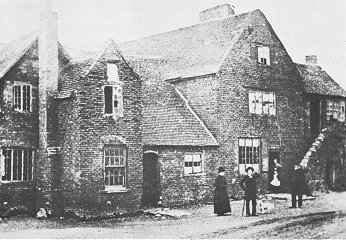
| The old workhouse
in Pardoes Lane where the new town hall was
built. From the Methodist recorder, 1901. |
|
On the day of Queen Victoria's Golden Jubilee,
21st June, 1887 there were many celebrations in the town,
including the laying of the foundation stone.
The
schools had broken up on the previous Friday for a weeks
holiday, and a public holiday was declared on the day
itself.
Most of the streets were elaborately decorated with
bunting, streamers, flags, coloured lights, paper
flowers, banners, and pictures of the Queen. |
| Church bells were rung, and services of thanksgiving
were held at each church, the principal one being All
Saints in Walsall Road. Pardoes Lane was renamed Victoria Street
in honour of the Golden Jubilee, and the Havelock Brass Band led a procession from All
Saints to Victoria Road for the foundation laying
ceremony. At two o'clock in the afternoon 400 old and
needy people were served with dinner in a marquee
erected on the site of the present football ground. At
four o'clock that afternoon children were provided with
tea at their respective schools. |
The Town Hall finally opened on Wednesday 31st October 1888,
but even then it had not been completed as all of the
available money had run out.
Apart from the original
£500 loan, £3,500 was borrowed from the Prudential
Insurance Company at an interest rate of £3.15s per
cent, per annum. Creditors kept pressing for their money
and so other loans had to be taken out from the same
source. |
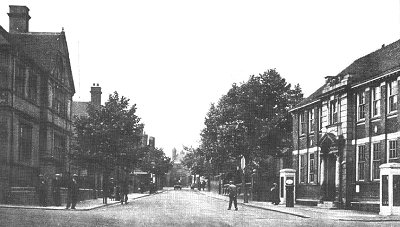
Darlaston Town Hall in about
1936. The Post Office on the right, opened in 1912. |
| Before building work had finished a further £560 had
been borrowed, and £440 raised from indoor markets held
in the Town Hall itself. A further £2,000 was raised by
public subscription. Another £160 was borrowed to cover
excess costs of the library, but it could not be
completed until James Slater offered to provide the
library, at his own expense, with whatever furniture was
required, suitable shelving for the books, and daily
London and local newspapers and magazines. In return the
Board had to agree to supply fire and light, pay for
cleaning, provide provision for the issue and receiving
of books at stated times during the week, and place the
management of the reading room and library in the hands
of James Slater and a committee of four, to be selected
by him. Two would be members of the Board, and two would
not. The agreement, made in May 1889 was accepted on
condition that it could be terminated on the giving of
one month's notice. Money was still in short supply
and so initially only the reading room was transferred
to the new library. Further loans were taken out, and
public events were held to raise funds for the library.
An unknown sum was also raised by public subscription.
On 29th July, 1891 a tea was held to celebrate the
opening of the new lending department, but this was
somewhat premature because although the walls had been
colour-washed, and lino and furniture provided, and
books purchased and catalogued, and the catalogue
printed, they were not ready to start lending books.
The first meeting of the Free Library Committee took place
on Monday 6th August 1891. During the meeting the
committee relieved Mr. Slater of the responsibility of
providing periodicals for the reading room, and chose
the following list of magazines:
Review of Reviews, Fortnightly Review, Nineteenth
Century New Review, MacMillan's Magazine, Sunday at
Home, Leisure Hour, Good Words, Cassel's Magazine, the
Strand Magazine, and Chamber's Journal.
The grand opening finally took place on Monday 14th
September, 1891 when the lending department opened its
doors to the public for the first time. Unfortunately
the public was slow to react, only seventeen books were
borrowed each day during the first week. This number
slowly grew, doubling and tripling over the next few
weeks. The library eventually grew in popularity and
became an important asset to the town.
The Library contained about 6,000
volumes. The expenses or maintenance were met out of the
one penny rate levied under the Public Libraries Act.
In the early 1920s the Chairman of the Free Library
Committee was Councillor J.
Yardley. A sum of £100 was bequeathed by the late S. E.
Adams which was invested in City of Birmingham Stock at
3½ percent. The income helped to pay for new books and
periodicals.
The original library opened in 1848 as the
"Mechanics Institute" on the corner of Dorsett Road and
Cock Street, next to the Dartmouth Arms. The building,
an old house was rented from Mr. Bruerton, a pawnbroker
for £28 per year. In 1875 it became the Institute
Library, the town's first public library containing 750
books, which were purchased by the local authority for
£75.
| Read about the
early library |
 |
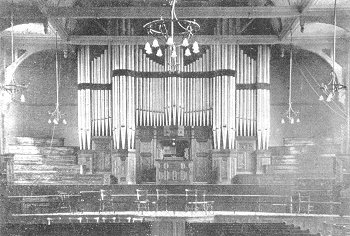
The Slater Memorial Organ.
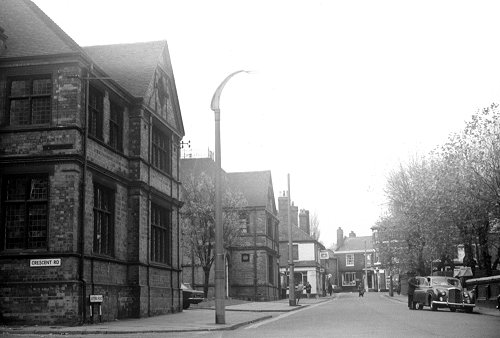
The Town Hall in the 1980s.
In November 1903 the Town Hall was presented with an
organ by Mrs. Slater, the widow of James Slater, a
previous chairman of the Local Board. |
| On the 1st of January, 1895 Darlaston became an
Urban District, and the Local Board became Darlaston
Urban District Council.
Their meetings were held at the Town Hall for the
next 70 years, until Darlaston became part of
Walsall in 1966.
The library moved to new premises on the corner
of King Street and re-opened on 5th August, 1987.
From then-on the Town Hall only housed the Social
Services department. |
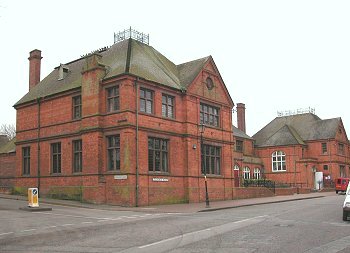
The Town Hall as it is today. |
|
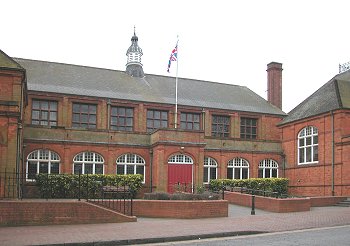
Another view showing the
main entrance. |
The main hall continued to be used for concerts,
plays, pantomimes, and jumble sales.
The town hall closed in September 2006 due to health and safety
concerns and its future looked uncertain. |
| Luckily help was at hand in the form of Walsall
Council who undertook a £325,000 restoration scheme
to restore the building to its former glory. The
work included roof repairs, rewiring, repainting,
upgrading the kitchen, and a refurbishment of the
Slater organ, which itself cost £7,500.
The building officially reopened in June 2008 and
is now used for concerts and events of all kinds. |
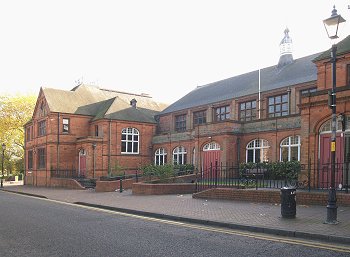
Looking towards Victoria
Park. |
|
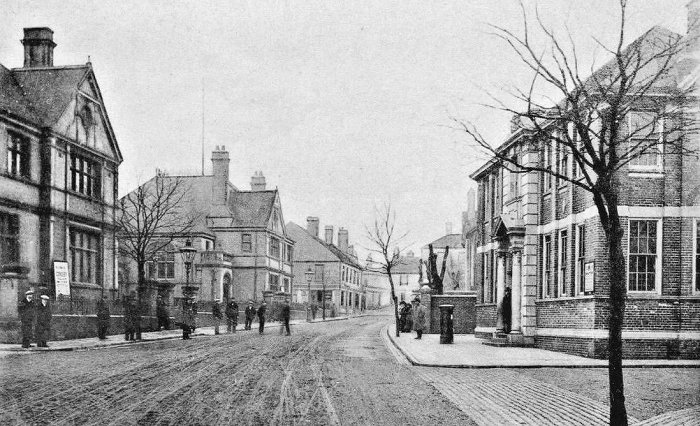
A view of the Town Hall
and the Post Office from around the start of the
First World War. From an old postcard. |
 |
 |
 |
Return to
Local Government |
Return to
Contents |
Proceed to
Education |
|